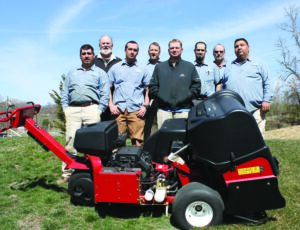By JODY BRADLEY
If you have never been on a golf course before, you have probably never seen the small holes left in the course after the aerification process. Golfers mistakenly think aerification throws off their game but some of the best golf games ever played were played after aerating the course. What is aerification?

The Sequoyah National Grounds Staff is shown (left-right) with the Aerating equipment: Marco Torres, Don Stewart, Billy Rhinehart – environment technician, Niall Connell – irrigation technician, Joel Krause – superintendent, Frankie Jenkins – assistant mechanic, Joseph Cooper, and Leon Sampson. Not pictured: Jason Walker- head mechanic and Mick Foulweather – assistant superintendent. (Photo courtesy of Jody Bradley)
Think about all the people and equipment that walk on a golf course. They compact the soil and crush the root system of grass cutting off the oxygen. Aerification adds oxygen back to the soil by punching tiny holes and is a necessary chore in maintaining golf courses. Aerifying the soil relieves soil compaction, provides a method to improve the soil mixture around the highest part of a green’s roots and reduces or prevents the accumulation of excess thatch.
Grass must have deep, healthy roots and good roots demand oxygen. In good soil, they get the oxygen from tiny pockets of air trapped between soil and sand particles.
At Sequoyah National Golf Club, the staff is doing preventative maintenance and preparing the course for the coming season. They will aerate over six miles of course including greens and tees, going over them three times. That is eighteen miles walking behind the aerating machine, and the staff does it twice a year.
So, the next time you are on an aerated course, remember that it will help improve the course over time. Without those little holes the grass could die. Do not blame your bad game on the superintendent or the aerification process.
Tips for your yard from the Sequoyah National staff
- Aerate. You can rent a roller to punch holes in your yard increasing its oxygen intake.
- Weed. Follow the directions on the package. Remember light and frequent applications is better than once and heavy and taking the chance of killing the wanted grass.
- Fertilize. Follow the directions. Light and frequent vs. heavy and infrequent will be better for the health of the lawn and keep you from having to mow it as often.




